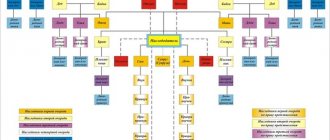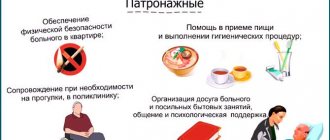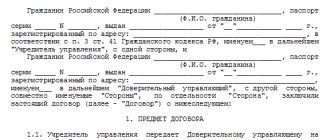Confirmation of kinship in the mass consciousness of Russians is associated with DNA testing to identify the father of the child. But such tests are carried out to collect alimony. And for some reason, it is overlooked that not a single notary will accept an application to open an inheritance case if there is no will, without documents confirming family ties.
In relation to father (mother) and son or daughter, everything is simple. It is enough to present a birth certificate. How to prove the relationship between uncle and nephew or grandfather or grandson? For many, this task seems insurmountable or difficult to solve. Let’s talk about how to confirm a relationship with a deceased relative.
When is confirmation of relationship with the deceased necessary?
The heir must confirm his relationship with the deceased in the following cases:
- When inheriting by law. Property is transferred in accordance with the order of inheritance based on family ties.
- When inheriting by will. Payment of state duty depends on the degree of relationship.
Article 1111 of the Civil Code of the Russian Federation allows a person to receive an inheritance, but only with full compliance with the requirements established by law.
Ownership and rental
Unlike the usual ownership of land during life as an owner, after death the resting place is leased to the family of the deceased. This means that, in fact, it is allowed to conduct burials and install objects of ritual significance on the site, since this is part of its intended purpose, but nothing else is allowed to be done with it. The sale, donation or other transfer of a related burial for someone else's use is strictly prohibited. The relatives of the person who is laid to rest in the grave only monitor the improvement of the territory entrusted to them and perform ritual actions that do not contradict the legislation of the Russian Federation and the internal regulations of the graveyard. Moreover, for the provision of various types of services - installation/dismantling of a tombstone or fence, digging a grave, performing a subburial with an urn, the management of the necropolis has the right to charge a fee.
Allocation of space in a cemetery
According to the legislation of the Russian Federation
Documents for burial
according to the legislation of the Russian Federation
Funeral arrangements
in St. Petersburg and the region
Documents confirming relationship with the deceased
The main documents evidencing family ties are issued by civil registry authorities.
This is a certificate of death, marriage, birth or adoption, change of surname. Each of these certificates is drawn up in accordance with the established form and must have the signature of an official and an official seal. The certificate is valid only if the original document is provided.
Additionally, you must provide your own passport or birth certificate if your relationship with a minor is confirmed.
Upon receipt of a supporting document from an interested person, the notary checks whether there are grounds for revoking the legal force of such a document.
A document may lose legal force under the following circumstances:
- significant wear;
- ink smearing;
- wrinkled;
- availability of fixes;
- illegible text.
Table “Procedure for confirming kinship for different categories of heirs”
| Degree of relationship | Confirmation procedure |
| Mother father | Birth certificate of the testator, parents' passports, document. |
| Brother/sister | Marriage certificate of the parents, birth certificate of the testator, birth certificate of the sister, marriage registration certificate of each sister if there was a change of surname. |
| Grandmother grandfather | The following types of evidence:
|
| Uncle Aunt |
|
If there are no documents
If there are not enough documents and it is not possible to find the original certificate, you must contact the registry office with an application for the production of a duplicate.
Civil registry office employees check the archive, search for the original document and prepare a duplicate based on it. A state fee is paid for making a copy.
If the documents contain errors
Federal Law No. 143 “On Acts of Civil Status” of November 15, 1997 provides for the procedure for making corrections to a previously issued certificate by civil registry authorities.
It is stipulated that if incorrect information, typos, or spelling errors are identified in the certificate, they must be corrected by registry office employees. To do this, the interested person sends an application and a copy of the incorrect document to the territorial registry office.
Can nephews claim inheritance and in what order?
Establishing the fact of family relations for inheritance
Obtaining documents from the civil registry office
To open an inheritance, one of the relatives of the deceased testator or the person specified in the will submits a handwritten application to the notary, which is confirmed by the necessary documents.
If they are absent, the person first contacts the registry office to receive them again.
You can contact any civil registry office, regardless of your place of residence or the place where the certificate was issued.
Required documents for application
Along with the application, the interested person must submit a personal passport and incorrectly compiled documents.
If we are talking about the need to provide a copy or duplicate, then it is enough to submit your passport.
An additional state fee is paid for making a copy of the document.
Deadlines for issuing documents
Preparing copies of documents takes the registry office employees approximately 10 days. This period is calculated taking into account the fact that the application is submitted to the registry office that issued the main document. If an interested person sends a request for the production of a duplicate certificate to the civil registry office of another locality, then the production time can be extended to one and a half months.
The law does not provide for the possibility of urgently receiving a response to such a request. But if there is a need to obtain a certificate urgently due to the end of the inheritance period, the interested person can ask the head of the registry office to prepare a response to the request, but not earlier than after 3 days.
Recognition of kinship in court
When confirming paternity of a deceased testator, one cannot do without the help of the court. The minor's representative or the child himself, who has reached the age of 18, performs the following steps:
- Preparation of a statement of claim to establish paternity.
- Collection of necessary documents.
- Submission of the claim to the court and payment of the state fee.
- The resolution of the dispute is essentially, which takes on average one and a half to two months.
- The court makes a final decision.
- Transfer of a court decision to a notary, who opens inheritance proceedings.
Documentation
A prerequisite for filing a claim is to draw up an inventory of the attached materials. All materials must be numbered and attached to the application.
Required documents include the following:
- applicant's passport;
- testator's passport;
- death certificate of the testator;
- refusal of the notary to include the child among the heirs;
- materials indicating paternity;
- payment of state duty.
The statement of claim is accompanied by copies of the specified documents, the originals are brought by the plaintiff to the court hearing.
Contents of the statement
The petition is drawn up taking into account the requirements of the Civil Code and must contain the following information:
- The header of the document, which contains the name of the court where the claim is being transferred. In the absence of the defendant, the magistrate's court located at the plaintiff's residence address will consider the appeals. The header contains the personal data of the applicant and the data of all interested participants.
- The introductory part describes the grounds and reasons for filing a claim to establish paternity.
- A detailed description of the circumstances confirming the existence of a family relationship.
- Legal requirements, namely confirmation of paternity, the requirement to include the child in the list of first-priority heirs.
- Date and signature of the claim.
- Description of the attached materials.
Sample and application form
State duty amount
The amount of the state duty is regulated by Article 333.19 of the Tax Code of the Russian Federation. According to part three of this article, in 2021 an adult child will have to pay 300 rubles for filing a claim.
When paying the state duty, the number of claims is taken into account, since the state duty is calculated separately for each legal claim.
Arbitrage practice
More often, conflicts arise due to the need to confirm the paternity of the deceased testator and the child. If it is impossible to conduct a DNA test, the court makes a decision based on the documents submitted by the child’s second parent.
If the submitted evidence is sufficient to confirm paternity, then the court makes a decision in favor of the applicant. Such evidence will include personal correspondence, call recordings, witness statements, certificates indicating cohabitation, and photographs.
After considering the claim, the judge makes one of the following decisions:
- full recognition of kinship;
- partial confirmation of relationship, that is, with the establishment of a number of restrictions;
- not satisfying the claim.
Grounds for establishing family ties
Situations in which confirmation of blood ties is required:
- when submitting documents to the notary to begin the process of accepting property;
- preparation of deed of gift;
Note! If the recipient and the donor are family members, then the receiving party is exempt from paying the mandatory fee (13% of the price of the property).
- collection of alimony;
- proof of nationality at immigration;
- other cases.
Lawyer's answers to questions about establishing kinship with the deceased
How to prove relationship with the deceased if we have different last names?
First of all, you need to contact the civil registry office to obtain a certificate of change of surname. After this, general documents are collected indicating the relationship. This could be a birth certificate, a death certificate, a marriage certificate, or an adoption certificate.
Is it possible to prove kinship with the father if there is a dash in the “Father” column?
Yes. To do this, you must file a claim with the court to recognize paternity. Since it is impossible to conduct a DNA study with a deceased testator, the applicant must prepare the maximum package of documents confirming paternity.
Can I prove my relationship without documents?
No. The notary takes into account only official documents drawn up in accordance with the requirements of the law.
How to prove relationship if there is no birth certificate?
You must contact the Civil Registry Office to obtain a duplicate birth certificate. If a person is already an adult and has issued a passport, then a copy of Form-1 completed before receiving the passport will serve as confirmation.
What else can be taken into account as evidence?
In legal proceedings to determine blood ties, the plaintiff may arrange for the preparation of additional documents confirming kinship with the deceased.
Such evidence may include:
- testimony of third parties (for example, those citizens who are related to both the plaintiff and the deceased);
- photos and videos from the family archive, where the possible successor and testator are captured together;
- correspondence;
- an extract from the house register indicating that the plaintiff and the deceased relative are registered in the same living space.
Expert opinion
Golubev Denis Petrovich
Lawyer with 7 years of experience. Specialization: civil law. Author of dozens of articles in the media
These methods can help win the case, but they are not direct evidence. An officially approved act is the main legal method of proving that a citizen and the deceased testator were in a family relationship.
This is important to know: How to correctly formalize the waiver of a share in a privatized apartment







